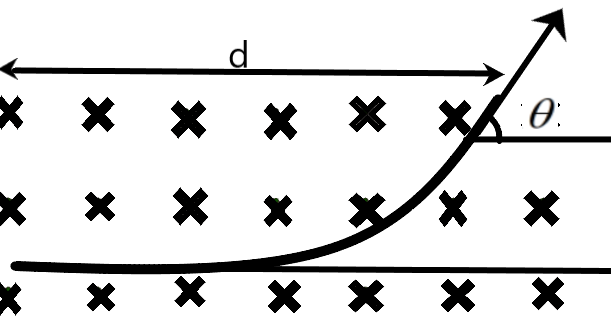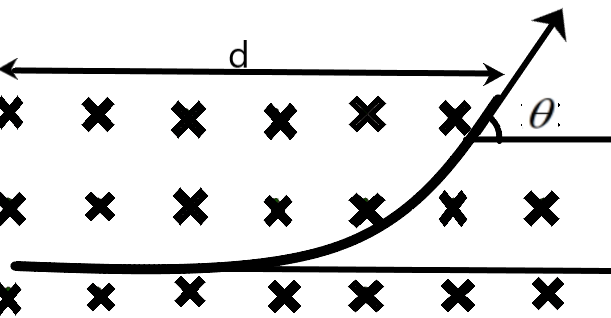
A particle of mass ‘m’ and charge ‘q’ is projected into a region having a perpendicular magnetic field B. Find the angle of deviation (figure) of the particle as it comes out of the magnetic field if the width ‘d’ of the region is very slightly smaller than

1.\[\dfrac{mv}{qB}\].
2. \[\dfrac{mv}{\sqrt{2}qB}\]
3. \[\dfrac{3mv}{qB}\]

Answer
557.4k+ views
Hint: We need to understand the relation between the deviation caused to an electric charge that is moving perpendicular to a magnetic field and the radius of the circular path the particle will be travelling to solve the given problem in different situations.
Complete answer:
We are given a situation in which an electric charge ‘q’ is moving into a magnetic field in the perpendicular direction. We know that the charge will get deviated by the magnetic field and will describe a circular path.

We know that the charge when encountering a magnetic field will describe a circular path depending on the perpendicular component of the velocity with which the particle enters the field. We can derive the radius from the centripetal force and the magnetic force as –
\[\begin{align}
& \dfrac{mv}{2qB} \\
& {{F}_{C}}={{F}_{B}} \\
& \Rightarrow \dfrac{m{{v}_{\bot }}^{2}}{r}=q{{v}_{\bot }}B \\
& \therefore r=\dfrac{mv\sin \theta }{qB}\text{ --(1)} \\
\end{align}\]
Now, we are given the radius for three situations. We can find the angle of deviation using the above relation.
1. \[r=\dfrac{mv}{qB}\]: We can equate the equation (1) to get the angle of deviation as –
\[\begin{align}
& \dfrac{mv}{qB}=\dfrac{mv\sin \theta }{qB} \\
& \Rightarrow \sin \theta =1 \\
& \therefore \theta =\dfrac{\pi }{2} \\
\end{align}\]
2. \[r=\dfrac{mv}{\sqrt{2}qB}\]: We can equate the given radius with (1) to get the angle of deviation as –
\[\begin{align}
& \dfrac{mv}{\sqrt{2}qB}=\dfrac{mv\sin \theta }{qB} \\
& \Rightarrow \sin \theta =\dfrac{1}{\sqrt{2}} \\
& \therefore \theta =\dfrac{\pi }{4} \\
\end{align}\]
3. \[r=\dfrac{mv}{2qB}\]: We can find the angle of deviation for this case also similarly as –
\[\begin{align}
& \dfrac{mv}{2qB}=\dfrac{mv\sin \theta }{qB} \\
& \Rightarrow \sin \theta =\dfrac{1}{2} \\
& \therefore \theta =\dfrac{\pi }{6} \\
\end{align}\]
We get the angles of deviation for all the given cases of radius as –
1. \[\theta =\dfrac{\pi }{2}\]
2. \[\theta =\dfrac{\pi }{3}\]
3. \[\theta =\dfrac{\pi }{6}\]
These are the required angles for the three given cases.
Note:
The velocity component of the charged particle along the perpendicular direction as that of the magnetic field determines the radius of the circular motion of the charged particle for a given mass and charge of the particle kept as a constant.
Complete answer:
We are given a situation in which an electric charge ‘q’ is moving into a magnetic field in the perpendicular direction. We know that the charge will get deviated by the magnetic field and will describe a circular path.

We know that the charge when encountering a magnetic field will describe a circular path depending on the perpendicular component of the velocity with which the particle enters the field. We can derive the radius from the centripetal force and the magnetic force as –
\[\begin{align}
& \dfrac{mv}{2qB} \\
& {{F}_{C}}={{F}_{B}} \\
& \Rightarrow \dfrac{m{{v}_{\bot }}^{2}}{r}=q{{v}_{\bot }}B \\
& \therefore r=\dfrac{mv\sin \theta }{qB}\text{ --(1)} \\
\end{align}\]
Now, we are given the radius for three situations. We can find the angle of deviation using the above relation.
1. \[r=\dfrac{mv}{qB}\]: We can equate the equation (1) to get the angle of deviation as –
\[\begin{align}
& \dfrac{mv}{qB}=\dfrac{mv\sin \theta }{qB} \\
& \Rightarrow \sin \theta =1 \\
& \therefore \theta =\dfrac{\pi }{2} \\
\end{align}\]
2. \[r=\dfrac{mv}{\sqrt{2}qB}\]: We can equate the given radius with (1) to get the angle of deviation as –
\[\begin{align}
& \dfrac{mv}{\sqrt{2}qB}=\dfrac{mv\sin \theta }{qB} \\
& \Rightarrow \sin \theta =\dfrac{1}{\sqrt{2}} \\
& \therefore \theta =\dfrac{\pi }{4} \\
\end{align}\]
3. \[r=\dfrac{mv}{2qB}\]: We can find the angle of deviation for this case also similarly as –
\[\begin{align}
& \dfrac{mv}{2qB}=\dfrac{mv\sin \theta }{qB} \\
& \Rightarrow \sin \theta =\dfrac{1}{2} \\
& \therefore \theta =\dfrac{\pi }{6} \\
\end{align}\]
We get the angles of deviation for all the given cases of radius as –
1. \[\theta =\dfrac{\pi }{2}\]
2. \[\theta =\dfrac{\pi }{3}\]
3. \[\theta =\dfrac{\pi }{6}\]
These are the required angles for the three given cases.
Note:
The velocity component of the charged particle along the perpendicular direction as that of the magnetic field determines the radius of the circular motion of the charged particle for a given mass and charge of the particle kept as a constant.
Recently Updated Pages
A man running at a speed 5 ms is viewed in the side class 12 physics CBSE

The number of solutions in x in 02pi for which sqrt class 12 maths CBSE

State and explain Hardy Weinbergs Principle class 12 biology CBSE

Write any two methods of preparation of phenol Give class 12 chemistry CBSE

Which of the following statements is wrong a Amnion class 12 biology CBSE

Differentiate between action potential and resting class 12 biology CBSE

Trending doubts
What are the major means of transport Explain each class 12 social science CBSE

Which are the Top 10 Largest Countries of the World?

Draw a labelled sketch of the human eye class 12 physics CBSE

How much time does it take to bleed after eating p class 12 biology CBSE

Explain sex determination in humans with line diag class 12 biology CBSE

When was the first election held in India a 194748 class 12 sst CBSE




